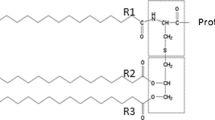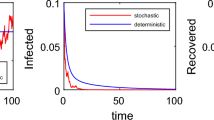Summary
The ability of NDV strains to induce interferon (IF) in chicks is closely related with their virulence. Virulent strains are more potent inducers than avirulent strains. With the avirulent strains, induction of maximum IF took place uniformly at the 2nd hour, whereas with the virulent strains considerably later, at times depending on the strain. The main source of early IF inducible with the avirulent strains is the spleen. Early IF is extremely sensitive to cortisone, but it is not significantly inhibited by FPA. Pretreatment of chicks with endotoxin brought about a state of tolerance. In contrast, the appearance of late IF is less sensitive to cortisone, it is prevented by FPA, hardly influenced by splenectomy and a tolerance to it can be induced by pretreatment with homologous virus, but can not be induced with endotoxin.
The mechanism of production of the two types of IF may be different.
Similar content being viewed by others
References
Baron, S.: Relationship of interferon and temperature to virulence of Newcastle disease virus: In: Newcastle Disease Virus: An Evolving Pathogen. (R. P. Hanson ed.), p. 205. The University of Wisconsin Press, Madison and Milwaukee (1964).
Campbell, J. B., andJ. S. Colter: Sensitivity to, and production of interferon by three variants of Mengo virus. Canad. J. Microbiol.13, 931 (1967).
Glasgow, L. A., andK. Habel: Role of polyoma virus and interferon in a herpes simplex virus infection in vitro. Virology19, 328 (1963).
Hallum, J. V., J. S. Youngner, andW. R. Stinebring: Interferon activity associated with high molecular weight proteins in the circulation of mice injected with endotoxin or bacteria. Virology27, 429 (1965).
Ho, M.: Interferon like viral inhibitor in rabbits after intravenous administration of endotoxin. Science146, 1472 (1964).
Ho, M., B. Postic, andY. H. Ke: The systemic induction of interferon. In: Interferon (G. E. W. Wolstenholme andM. O'Connor, eds.), p. 19. J. A. Churchill Ltd., London (1968).
Ke, Y. H., andM. Ho: Characterization of virus- and endotoxin-induced interferons obtained from the serum and urine of rabbits. J. Virol.1, 883 (1967).
Lomniczi, B.: Viral pathogenicity and interferon production. Acta vet. Sci. hung.18, 313 (1968).
Lomniczi, B., G. Pethes, andF. Kemenes: Effect of X-irradiation and bursectomy on interferons induced in chickens by Newcastle disease virus. Z. Immun.-Forsch.137, 314 (1969).
Postic, B., C. De Angelis, M. K. Breinig, andM. Ho: Effects of cortisol and adrenalectomy on induction of interferon by endotoxin. Proc. Soc. exp. Biol. (N.Y.)125, 89 (1967).
Sellers, R. F.: Virulence and interferon production of strains of foot-and-mouth disease virus. J. Immunol.93, 6 (1964).
De Somer, P., A. Billiau, andE. De Clercq: Influence of corticoid administration or stimulation and of N-methylacetamide on interferon production in vivo in the rat. In: The Interferons (G. Rita, ed.), p. 65. Academic Press, New York and London (1968).
Stanček, D.: The role of interferon in tick-borne encephalitis virus infected L-cells. III. The effects of temperature on the production of virus and interferon by L cells during acute and persistent infection. Acta virol.9, 298 (1965).
Subrahmanyan, T. P., andC. A. Mims: Fate of intravenously administrated interferon and the distribution of interferon during virus infections in mice. Brit. J. exp. Path.47, 168 (1966).
Westphal, O., andK. Jann: Bacterial lipopolysaccharides. Meth. Carbohydr. Chem.5, 83 (1965).
Wagner, R. R., A. H. Levy, R. M. Snyder, G. A. Ratcliff, andD. F. Hyatt: Biological properties of two plaque variants of vesicular stomatitis virus (Indiana serotype). J. Immunol.91, 112 (1963).
Youngner, J. S., andW. R. Stinebring: Interferon appearance stimulated by endotoxin, bacteria, or viruses in mice pretreated with E. coli endotoxin or infected with Mycobacterium tuberculosis. Nature (Lond.)208, 456 (1965).
Author information
Authors and Affiliations
Rights and permissions
About this article
Cite this article
Lomniczi, B. Systemic induction of interferon in chicks with various NDV strains. Archiv f Virusforschung 30, 159–166 (1970). https://doi.org/10.1007/BF01250184
Received:
Issue Date:
DOI: https://doi.org/10.1007/BF01250184




